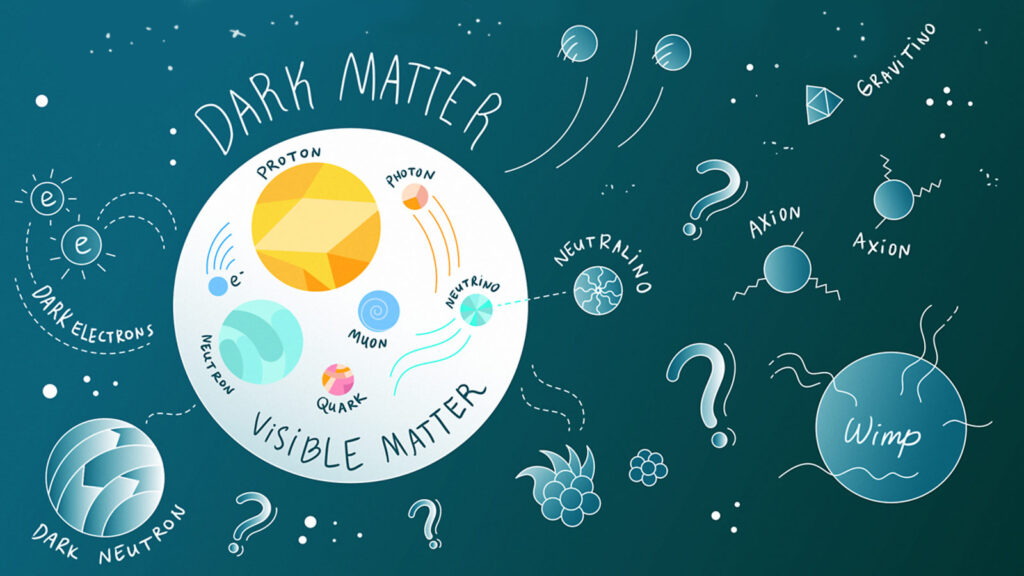Author: Darina Öö, King’s College London, UK
With the capability to detect elusive dark matter particles, the newly developed detector, as tall as Big Ben, marks a potentially significant milestone in the search to understand the mysterious nature of the universe.
Dark matter is one of the biggest mysteries of the Universe. Astronomers have been trying to understand it for decades. They’ve figured out how many stars and how much gas there is by measuring the radiation they give off; but when they calculate the gravity of stars, galaxies, and galaxy clusters, the numbers just don’t add up. They’re too massive.
So, what’s wrong? Well, there are two ways to look at this. One is to say that there’s matter in the Universe that we can’t see with our telescopes (which is referred to as dark matter). The other is to change our understanding of gravity. Most experts choose the first option. And who can blame them?
Rewriting the laws of physics is no easy feat. Plus, every time scientists try to explain one observation with a new law of gravity, they end up contradicting another. So, the idea that there’s some invisible matter out there seems like the better choice.
Most astronomers assume the existence of dark matter. What does it consist of? Could it be objects common to the cosmos, too dim for our telescopes? Black holes, brown dwarfs, something like that… Undoubtedly, they also contribute to the invisible matter of the Universe; except that there is five times as much dark matter as ordinary matter (1).
We know something about the eras when the first atomic nuclei and atoms were formed; and based on this knowledge, there simply cannot be as many atomic nuclei in a cubic parsec today as the dark matter requires.
True, these calculations are not completely reliable. There are some rough edges there that you can grab if you want to. Astronomers do not dismiss the possibility that it is not dark matter that is fundamentally invisible, and that our telescopes are not sensitive enough.
But what if the preachers of cosmology are right, and dark matter does not consist of atoms or nuclei? Then we’d have to admit that it’s made up of some other particles.

Physicists have a number of candidates for this role, see Figure 1. In their attempts to go beyond the Standard Model, theorists have accumulated a whole zoo of particles that may exist, but they are not certain.
Imagine that space is literally swarming with invisible particles. They pass through our bodies in an endless, huge stream.
Why don’t we notice this? Because these particles almost never collide with atomic nuclei or electrons. And only very sensitive detectors, specially designed for this purpose, can register them.
Well, it might be that they are no longer science fiction…
The AION (The Atom Interferometric Observatory and Network) detector, see Figure 2, is designed to detect such dark matter candidates – ultra-light bosons with a sub-eV mass such as dilatons, moduli, relaxions, as well as axions (3-4).

AION’s proposed solution is a next-generation atom interferometer that employs the superposition and interference of ultra-cold strontium atoms, the same used in state-of-the-art atomic clocks (4).
However, such particles interact weakly and for them to enter into such interaction with an atom, it must literally crash head-on into the atomic nucleus. This is an extremely unlikely event, but these are the very rare cases that AION is designed to catch.
According to the New York Times: “The best way to shift the odds, as well as seek out a wider range of potential particles, is to make the equipment bigger.” And AION takes this to a whole new level (6).
The first stage of the project is to build and commission a 10m detector and develop the technology for a 100m detector located in a mine shaft (4). Just imagine a detector the size of Big Ben underground! The ultimate objectives would be a full-scale terrestrial kilo-meter detector and a satellite-based detector (3).
1. Cooke, M. (no date) Doe explains…dark matter, Energy.gov. Department of Energy’s Office of Science . Available at: https://www.energy.gov/science/doe-explainsdark-matter (Accessed: April 17, 2023).
2. Sandbox Studio, Chicago with Ana Kova. Four things you might not know about dark matter [Internet]. symmetry magazine. [cited 2023Mar7]. Available from: https://www.symmetrymagazine.org/article/december-2013/four-things-you-might-not-know-about-dark-matter
3. An Atom Interferometer Observatory and Network (AION) [Internet]. Aion @ imperial: Home. [cited 2023Mar7]. Available from: https://www.hep.ph.ic.ac.uk/AION-Project/
4. Badurina L, Bentine E, Blas D, Bongs K, Bortoletto D, Bowcock T, et al. IOPscience [Internet]. Journal of Cosmology and Astroparticle Physics. IOP Publishing; 2020 [cited 2023Mar7]. Available from: https://iopscience.iop.org/article/10.1088/1475-7516/2020/05/011
cernblind. CERN accelerating science [Internet].
5. The AION Logo | Drush Site-Install. 2022 [cited 2023Mar7]. Available from: https://aion-project.web.cern.ch/news/aion-logo
6. Whipple T. Scientists seek enlightenment in the deepest, Darkest mine [Internet]. The Times & The Sunday Times: breaking news & today’s latest headlines. The Times; 2022 [cited 2023Mar7]. Available from: https://www.thetimes.co.uk/article/scientists-seek-enlightenment-in-the-deepest-darkest-mine-9d9bz9bxt
